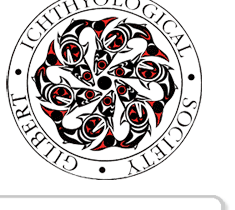
SUMMARY OF THE PAST AND A PROGNOSIS OF THE FUTURE OF THE SOCIETY
A retrospective consideration of the Society suggests to this rather biased observer that the organization has accomplished its original goals. It has brought together "fish folk" from Oregon and Washington on an annual basis. The Society has fostered communication between ichthyologists and other fishery people from the two states in a worthwhile and entertaining manner. Indeed, membership in the Society has expanded geographically, with members hailing from British Columbia and California in addition to the original two states. Many Fellows of the Society look forward to the Annual Meetings as a chance to visit with old friends and to make new contacts.
The Society provides a site for graduate students to interact with their peers as well as with professionals in the fields of ichthyology and fishery biology. The organization also serves as a forum where students can present their first, or early, papers to an audience of their peers, thus offering them valuable experience. The papers presented are overwhelmingly of high quality. Lively discussion often follows the presentation.
The Gilbert Ichthyological Society provides one of the very few opportunities in the Pacific Northwest for interaction of this kind. Numerous research collaborations between students and between students and faculty have resulted from insights gained at Annual Meetings of the Society.
Over the years the organization of Annual Meetings of the Society has evolved into a general pattern. Registration, an "unstructured social," and a Business Meeting are held on the first day (normally a Friday afternoon and evening). The second day is routinely devoted to formal presentations of scientific papers. A banquet is held the evening of the second day, often featuring a "keynote" speaker. Facility checkout is the morning of the third day (usually a Sunday) after breakfast.
The Bye-Laws of the Society have evolved over time to more fully represent the desires of the membership. Among other changes in the "laws," the original concept of "Foreign Members," representing membership of individuals from states other than Oregon and Washington, has been dropped. A category of "Honorary Members" has been established to honor those people who are not professional fishery scientists but who have contributed to the benefit of the Society or to the profession. The Society has consistently rejected, by postponing action on the "motion to establish," a scientific journal for the organization. The association has recently formed an alliance with the Society of Northwestern Vertebrate Biology, but what this will mean for the Society is not yet clear. The Society has held their Annual Meetings at some lovely locations, including the Pack Forest Conference Center near Eatonville, Washington, the Hatfield Marine Science Center in Newport, Oregon, and at McKenzie Bridge, Oregon. Other fine locations to hold annual meetings, such as the Friday Harbor Laboratories in Washington, have proved to be difficult to reach and, hence, a less popular site.
Membership in the Society has increased to about 190 Fellows, but most members are inactive (Fig. 65). About 53% of those inducted attend at least one subsequent Annual Meeting.119 This dormancy of the membership is likely due to the nature of the organization in that it depends primarily on recruitment of graduate students who may later move to other parts of the country and no longer attend meetings.
Attendance at Annual Meetings of the Society has declined recently (Fig. 65). Marketing and advertising the Annual Meetings has been limited and sporadic. This lack of publicity for the organization is due to the voluntary nature of the group. The Society has a web site, but it has not always been kept current.
Dues are not assessed by the Society and the "sense" of the organization appears to reject the idea of membership fees. Thus the costs of holding an annual meeting must be borne by those attending the conference. Costs at annual meetings in Oregon have been lower than in Washington due to the use of facilities at the Hatfield Science Center in Newport. In Washington, Annual Meetings have been held at University of Washington facilities, and the UW conference centers are not cheap.
Attendees at the Annual Meetings held at the Pack Forest Conference Center seemed generally pleased with the site, facilities, and food. In 2000 the organizers of the Annual Meeting were hindered by the requirement that the Society guarantee the Center sixty overnight guests in order to have sole use of the facilities. Attendance (about 38 people) at the 2000 meeting was far less than the required sixty guests and the meeting ran a deficit. The deficit was made up out of the organizerís pocket. Some adjustments to the Annual Meeting procedures will be necessary if the Society chooses to meet again at the Pack Forest Conference Center.
The Society seems to be relatively stable, but members need to devote more effort to marketing to assure better attendance at the Annual Meetings. The Society also needs to address the long-term problem of where to hold their Annual Meeting, particularly in Washington State.
Several members of the Society who have played important roles in the origin and development of the association deserve formal recognition for their contributions. Foremost among these is Ted Pietsch, who has devoted countless hours and personal funds to the development of the Gilbert Ichthyological Society. Douglas Markle has continuously organized the meetings held in Oregon. Phil Harris was a major participant in the founding of the Society and continues to be an enthusiastic supporter of the association. Wayne Palsson has been a fervent advocate of GIS, has arranged Society "field trips," and has held fine gatherings for the group at his house. James Orr has served as President of the Society, has been a long-term Secretary of the association, and has held Society gatherings at his home. He is a fountain of knowledge about the Society. Those members who have served as officers of the Society are listed in Appendix 24. Distinguished Fellows are listed in Appendix 25.

email webmaster.

